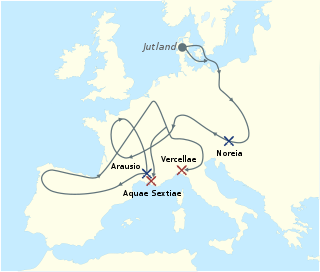Related Research Articles

The 1st century BC, also known as the last century BC and the last century BCE, started on the first day of 100 BC and ended on the last day of 1 BC. The AD/BC notation does not use a year zero; however, astronomical year numbering does use a zero, as well as a minus sign, so "2 BC" is equal to "year –1". 1st century AD follows.

Year 100 BC was a year of the pre-Julian Roman calendar. At the time it was known as the Year of the Consulship of Marius and Flaccus and the First Year of Tianhan. The denomination 100 BC for this year has been used since the early medieval period, when the Anno Domini calendar era became the prevalent method in Europe for naming years.
This article concerns the period 69 BC – 60 BC.
This article concerns the period 79 BC – 70 BC.
80s BC is the time period from 89 BC – 80 BC.

This article concerns the period 109 BC – 100 BC.
This article concerns the period 139 BC – 130 BC.
This article concerns the period 159 BC – 150 BC.

The Second Servile War was an unsuccessful slave uprising against the Roman Republic on the island of Sicily. The war lasted from 104 BC until 100 BC. It was one of three Servile Wars, spaced approximately 30 years apart.

The Third Servile War, also called the Gladiator War and the War of Spartacus by Plutarch, was the last in a series of slave rebellions against the Roman Republic known as the Servile Wars. This third rebellion was the only one that directly threatened the Roman heartland of Italy. It was particularly alarming to Rome because its military seemed powerless to suppress it.
The Servile Wars were a series of three slave revolts in the late Roman Republic:

The gens Licinia was a celebrated plebeian family at ancient Rome, which appears from the earliest days of the Republic until imperial times, and which eventually obtained the imperial dignity. The first of the gens to obtain the consulship was Gaius Licinius Calvus Stolo, who, as tribune of the plebs from 376 to 367 BC, prevented the election of any of the annual magistrates, until the patricians acquiesced to the passage of the lex Licinia Sextia, or Licinian Rogations. This law, named for Licinius and his colleague, Lucius Sextius, opened the consulship for the first time to the plebeians. Licinius himself was subsequently elected consul in 364 and 361 BC, and from this time, the Licinii became one of the most illustrious gentes in the Republic.

The Cimbrian or Cimbric War was fought between the Roman Republic and the Germanic and Celtic tribes of the Cimbri and the Teutons, Ambrones and Tigurini, who migrated from the Jutland peninsula into Roman-controlled territory, and clashed with Rome and her allies. The Cimbrian War was the first time since the Second Punic War that Italia and Rome itself had been seriously threatened.

Manius Aquillius was a Roman politician and general during the late Roman Republic. He was a member of the ancient Roman gens Aquillia, probably a son of Manius Aquillius, consul in 129 BC. Aquillius served as Consul of Rome with Gaius Marius in 101 BC. Before his consulship, during the Cimbrian War, he had served as a legate under Marius in Gaul. He played a pivotal role during the Battle of Aquae Sextiae where he surprised the Teutones by attacking them from behind. As consul he crushed a slave revolt in Sicily by defeating Athenion of Cilicia in single combat, a victory that was commemorated by Aquillius's family by coinage issued decades later. At the start of the First Mithridatic War he was defeated and captured by Mithridates VI of Pontus who had him executed by pouring molten gold down his throat.

Eunus was a Roman slave from Apamea in Syria who became the leader and king of the slave uprising in the First Servile War (135 BC–132 BC) in the Roman province of Sicily. According to the historian Florus, the only reason his name is remembered is due to the severe defeats he inflicted on the Romans.
Lucius Licinius Lucullus was a politician and a general of the Roman Republic. He was the eldest son of Lucius Licinius Lucullus, the consul of 151 BC. He, however, did not achieve the political success of his father and failed to hold the consulship, reaching only the position of praetor in 104 BC. During his praetorship he first successfully put down the Vettian Revolt, a minor slave revolt in Campania, before being sent to take command in Sicily during the Second Servile War. He was later relieved of his command and prosecuted for embezzlement upon his recall to Rome. Being convicted, he was banished from the city and lived the remainder of his life in exile. He is the father of the more famous Lucius Licinius Lucullus, who defeated Mithridates and Tigranes in the Third Mithridatic War.
Publius Licinius Nerva was a Roman politician during the Late Roman Republic. As a propraetor he was assigned as Governor of Sicily in 104 BC at the outbreak of the Second Servile War.
Athenion was a man of ancient Cilicia who was a major figure in the Second Servile War in Sicily, and had a career similar to that of the Cilician Cleon.